Mt. Merapi (2968 m)
With its famous "Puncak Garuda" - Garuda Peak
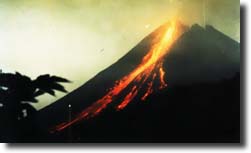 This fire mountain remains one of the most active and dangerous volcano in the world. It can be seen from its name – Merapi from Javanese world Meru means mountain and Api means fire.
The latest eruption
This fire mountain remains one of the most active and dangerous volcano in the world. It can be seen from its name – Merapi from Javanese world Meru means mountain and Api means fire.
The latest eruption
In the early morning of Saturday, July 11, 1998, at 4.59 a.m, the volcano erupted again after days of ominous rumblings and minor tremors. At once, following the explosion, a black smoke rose up to more than 3000 m above its peak, spewing heat clouds and volcanic ash and debris several kilometers away. The ash hit the area as far as 60 Km away on the West of the mountain. Many surrounding towns were blanketed with white ash. The most dangerous killers are the heat clouds. This 3000 0 Celsius heat substance should melt and burnt easily anything found on its way. "Luckily, this cloud blew to an uninhabited area west of the mountain. In 1994 sudden eruption, 66 people of the South-West slope have been killed by this heat cloud.
 The local people call this heat cloud in Javanese Wedus Gembel (Wedus – a sheep; gembel – thick curly hair), as it looked like. Usually the local inhabitants should flee from their villages only after seeing the emergence of the "curly sheep", as considered the real menace of the "Merapi Rulers". In 1997, thousand of Merapi villagers have been evacuated when it began spewing ash and lava.
The local people call this heat cloud in Javanese Wedus Gembel (Wedus – a sheep; gembel – thick curly hair), as it looked like. Usually the local inhabitants should flee from their villages only after seeing the emergence of the "curly sheep", as considered the real menace of the "Merapi Rulers". In 1997, thousand of Merapi villagers have been evacuated when it began spewing ash and lava.
The worst eruption was in 1930 which killed about 1300 people. People did not know exactly how many thousand or even million times, Merapi has been erupted since its birth. In the 10th century, its ashes had buried totally a temple 15 km southward. Probably its unbearable activity had pushed eastward the Hindu Mataram kingdom from Prambanan, central Java to East Java in the 10th century.
But Merapi does not act always as "a bad guy", most of the time "it is a good guy", handsomely gives tremendous fertility to the land, stands strongly guarding the nature
Mountaineering Routes
There are 2 routes lead to Mt. Merapi. The first is thru Yogyakarta from the South, the second is thru the village of Selo, Boyolali from the north.
From Yogyakarta
From the city of Yogya, a climber shall travel to Kaliurang – a small nice 1300 m high mountain resort, 27 Km north of Yogya and then continue to Kimahrejo village, the last village to the top. A guide, sufficient supply (water etc), any information are available here. Normally, it shall take 6 hours of climbing to the peak.
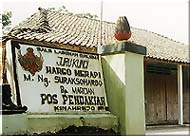 The path should lead to the border of last vegetation, the timberline, Kendit. Going to the peak, walk thru labile and stony paths, the journey is strenuous. On the peak, one can see the sulphur crater and heavenly panoramic views. It is strongly advised to all mountaineers to prepare themselves adequately, before any climbing. Be careful of accident which could happened due to stone sliding or falling down.
The path should lead to the border of last vegetation, the timberline, Kendit. Going to the peak, walk thru labile and stony paths, the journey is strenuous. On the peak, one can see the sulphur crater and heavenly panoramic views. It is strongly advised to all mountaineers to prepare themselves adequately, before any climbing. Be careful of accident which could happened due to stone sliding or falling down.
Unfortunately this path is closed since November 1994 due to dangerous activities of the mountain, until further notice. If a climber insists, he could climb only until Miji Hill, from where he can enjoy the beautiful nature. A special permit is needed to enter the Miji hill, which is considered as a dangerous area.
Ritual Ceremony
 Every year the Kraton – Palace of Yogyakarta gives regular offering in Ngestiaji, north of Kimahrejo village. The ritual starts from the house of mbah (Grand-father) Marijan, a native of the village, assigned by Kraton of Yogya as the gate keeper (Juru Kunci) of Merapi. The offering are meant for the welfare of the Sultan and the people of Yogyakarta and prosperity of the country, to commemorate the coronation of the Sultan. This year is due on November 20 and 21, 1998.
Every year the Kraton – Palace of Yogyakarta gives regular offering in Ngestiaji, north of Kimahrejo village. The ritual starts from the house of mbah (Grand-father) Marijan, a native of the village, assigned by Kraton of Yogya as the gate keeper (Juru Kunci) of Merapi. The offering are meant for the welfare of the Sultan and the people of Yogyakarta and prosperity of the country, to commemorate the coronation of the Sultan. This year is due on November 20 and 21, 1998.
Trekking in Kaliurang
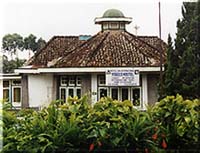 Besides mountain climbing, there are other natural tourist activities, organized to adore the breath-taking beauty of Mt. Merapi. Interested party can easily contact
Besides mountain climbing, there are other natural tourist activities, organized to adore the breath-taking beauty of Mt. Merapi. Interested party can easily contact
-
Vogels Homestay
Jalan Astanamulya 76
Kaliurang, Yogyakarta
Phone. 0274-895208
Contact person: Mr. Christian Awuy, who has developed these activities since 1990 with high dedication.
What are the offer?
- Mt. Merapi daily lava Tour.
 Starting from 03.00 a.m in the morning until 08.00 am. Including local breakfast in a hut by the side of river Kuning.
Starting from 03.00 a.m in the morning until 08.00 am. Including local breakfast in a hut by the side of river Kuning.
The group shall go up to Miji hill, about 1,5 h walk from Vogel’s.
Sunrise can be enjoyed from here, and if lucky, a traveler could see the sliding of the burning lava from the top.
- Village Tour
- Bushwalk and rice field tour
 Quite frankly, these nature oriented outdoor sport and adoration activity have been followed by more and more tourists, local as well as foreign. A traveler could see easily the rivers where the hot lava flows, as in the river of Boyong, in the South slope.
Quite frankly, these nature oriented outdoor sport and adoration activity have been followed by more and more tourists, local as well as foreign. A traveler could see easily the rivers where the hot lava flows, as in the river of Boyong, in the South slope.
The comments of some travelers are self-explanatory:
"The Merapi got be some kind of myth ……. a great experience to see mother nature so close and it is a must if you visit Yogya" (Martin, Frankfurt)
"Mt. Merapi is very impressive – that lava can really move. Don’t forget warm clothes. It can get really chilly- up there, especially while sitting in the pre-down watching the stars and lava." (Karen, Canada)
From Selo Village, Boyolali
The other route is thru Selo village, from the north of Merapi. This cool hilly village (1500 M high) located on the slopes of Mt. Merapi, in the south and Mt. Merbabu in the north. It’s about 40 Km, north-west of Solo city.
The climbers could prepare supplies in this village, there are some nice accommodations here. Tour guide is also available, by contacting Pak Warsito of Lencoh village, Selo. Normally, the climbing to the peak should take 6 hours. The way back to Selo, is approximately 4 hours.
Most climbers prefer to start early hours at 2.00 or 3.00 a.m from Selo base camp, catching the sunrise from the peak and avoiding thick fog which usually appears mid-day.
The climbing
- First from the village base camp, the climbers shall walk 1 km upward to a small Joglo house.
- Then take a small path thru tobacco and vegetable gardens, pass a pine wood until "Pole 1".
- From Pole 1 to Pole 2, walk thru open hill with strong wind.
- From Pole 2 until a place locally known as Pasar Bubrah (Ruined Market), the vegetation are rare, the wind blows very strongly.
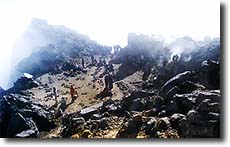 It has to be noted that Selo trekking is very steep from the start, a climber should walk carefully thru a small sandy and stony path with deep ravine on the right or left side. Pasar Bubrah, is a stone plain right under the peak. It shall take another hour to climb to top of Mt. Merapi. One has to climb adroitly, passing thru the labil sharp stones and windy road.
It has to be noted that Selo trekking is very steep from the start, a climber should walk carefully thru a small sandy and stony path with deep ravine on the right or left side. Pasar Bubrah, is a stone plain right under the peak. It shall take another hour to climb to top of Mt. Merapi. One has to climb adroitly, passing thru the labil sharp stones and windy road.
The Garuda Peak

 Reaching the peak, a stony plain with gigantic active crater, with strong smell of sulphur vapor. The most top peak is a huge stone in the form of Garuda Bird (Indonesia mythological bird) looks like a flying Eagle. A climber should be very proud and happy to be here.
Reaching the peak, a stony plain with gigantic active crater, with strong smell of sulphur vapor. The most top peak is a huge stone in the form of Garuda Bird (Indonesia mythological bird) looks like a flying Eagle. A climber should be very proud and happy to be here.
Look at the beautiful panoramic view around, enjoy the crystal clear sunrise, see the other peaks of mountains as Mt. Sindoro, Mt. Sumbing, Mt. Lawu, located hundred km away and the blue South Sea, southward of Yogyakarta and might be a bit worried to watch very closely the active crater with real hot lava inside.
The Ritual Ceremony
Every year in the Javanese New Year, 1st of Suro, the Selo villages make traditional offering to Mt. Merapi, called "Sedekah Gunung" (Mountain offering). They hope to live in safety and good welfare with enough crops from their land. The process of offering starts at the village house and then the burial of a Buffalo head shall take place on the peak of Mt. Merapi, or if the condition is dangerous then it shall be buried in Pasar Bubrah.
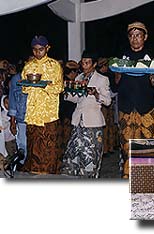
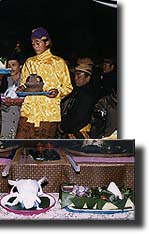
More about Merapi’s eruption
- When Merapi erupted in the morning July 11, 1998, about 3 million cubic meters of volcanic ash and toxic debris have been spewed from the crater.
- After eruption, it "coughs" many times, the noise is like flying supersonic jet. It indicates the boiling magma under the earth is pushing upstairs, it’s blazing.
- The blazing process "followed by the emergence of dangerous hot clouds.
The height of hot cloud is about 4 M, and could flow as far as 3 to 4 Km away.
- Sometimes it is repeatedly "booming" with horrible sound from inside the crater.
- Hot clouds also follow volcanic lava flows.
- At present, about 4 million cubic meters of lava are in the mouth of the crater. Its flow must be anticipated soon. Some "lava canals" have been built around the slope to channel its flow.
- And then, the time comes when Merapi is again at peace. High, green, beautiful. That’s nature.

 It has to be noted that Selo trekking is very steep from the start, a climber should walk carefully thru a small sandy and stony path with deep ravine on the right or left side. Pasar Bubrah, is a stone plain right under the peak. It shall take another hour to climb to top of Mt. Merapi. One has to climb adroitly, passing thru the labil sharp stones and windy road.
It has to be noted that Selo trekking is very steep from the start, a climber should walk carefully thru a small sandy and stony path with deep ravine on the right or left side. Pasar Bubrah, is a stone plain right under the peak. It shall take another hour to climb to top of Mt. Merapi. One has to climb adroitly, passing thru the labil sharp stones and windy road.